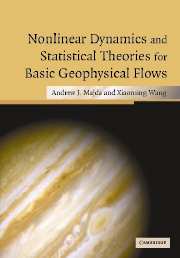Book contents
- Frontmatter
- Contents
- Preface
- 1 Barotropic geophysical flows and two-dimensional fluid flows: elementary introduction
- 2 The response to large-scale forcing
- 3 The selective decay principle for basic geophysical flows
- 4 Non-linear stability of steady geophysical flows
- 5 Topographic mean flow interaction, non-linear instability, and chaotic dynamics
- 6 Introduction to information theory and empirical statistical theory
- 7 Equilibrium statistical mechanics for systems of ordinary differential equations
- 8 Statistical mechanics for the truncated quasi-geostrophic equations
- 9 Empirical statistical theories for most probable states
- 10 Assessing the potential applicability of equilibrium statistical theories for geophysical flows: an overview
- 11 Predictions and comparison of equilibrium statistical theories
- 12 Equilibrium statistical theories and dynamical modeling of flows with forcing and dissipation
- 13 Predicting the jets and spots on Jupiter by equilibrium statistical mechanics
- 14 The statistical relevance of additional conserved quantities for truncated geophysical flows
- 15 A mathematical framework for quantifying predictability utilizing relative entropy
- 16 Barotropic quasi-geostrophic equations on the sphere
- Index
12 - Equilibrium statistical theories and dynamical modeling of flows with forcing and dissipation
Published online by Cambridge University Press: 30 November 2009
- Frontmatter
- Contents
- Preface
- 1 Barotropic geophysical flows and two-dimensional fluid flows: elementary introduction
- 2 The response to large-scale forcing
- 3 The selective decay principle for basic geophysical flows
- 4 Non-linear stability of steady geophysical flows
- 5 Topographic mean flow interaction, non-linear instability, and chaotic dynamics
- 6 Introduction to information theory and empirical statistical theory
- 7 Equilibrium statistical mechanics for systems of ordinary differential equations
- 8 Statistical mechanics for the truncated quasi-geostrophic equations
- 9 Empirical statistical theories for most probable states
- 10 Assessing the potential applicability of equilibrium statistical theories for geophysical flows: an overview
- 11 Predictions and comparison of equilibrium statistical theories
- 12 Equilibrium statistical theories and dynamical modeling of flows with forcing and dissipation
- 13 Predicting the jets and spots on Jupiter by equilibrium statistical mechanics
- 14 The statistical relevance of additional conserved quantities for truncated geophysical flows
- 15 A mathematical framework for quantifying predictability utilizing relative entropy
- 16 Barotropic quasi-geostrophic equations on the sphere
- Index
Summary
Introduction
In the previous chapters we discussed various equilibrium statistical theories. These statistical theories are developed for the idealized inviscid unforced geophysical flows. However, as we have discussed in Section 10.4, virtually all practical geophysical flows are subject to both forcing and dissipation. For instance, the earth's atmosphere is subject to intense random small-scale forcing from convective storms, and the ocean is subject to forcing from unresolved baroclinic instability processes on a small length scale. Thus, a natural question to ask is whether the equilibrium statistical theories can be applied in a forced and damped environment. The purpose of this chapter is to address this question. More precisely, we want to provide answers to the applied issue (A-4) and theoretical issue (T-5) from Chapter 10.
As was discussed in Section 10.4, equilibrium statistical theories will not be able to approximate geophysical flows in a statistical sense for all forcing. This is not a surprise, since intuitively we could only expect equilibrium theories to succeed when the flow is near equilibrium. What we are interested in here are external forcing which is random and small scale in space and kicks in time. This kind of forcing mimics the small-scale random forcing in the atmosphere and ocean as discussed above and in Chapter 10. The “quasi-equilibrium” state of the geophysical flow is achieved if the inverse cascade of energy from the small scales, where the external forcing occurs, to the large scales (the scale characterized by the equilibrium statistical theory) is sufficiently weak.
- Type
- Chapter
- Information
- Publisher: Cambridge University PressPrint publication year: 2006



